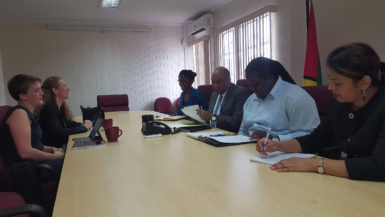A team from Norway met with Minister of Natural Resources (MNR) Raphael Trotman on Wednesday but a press release issued by his ministry yesterday on the meeting made no mention of the controversial Amaila Falls Hydro Power Project (AFHP) which the public has been expecting answers on.
There was also no word on the US$80m in funds from the Norway forest protection pact which was deposited with the Inter-American Development Bank (IDB) for use on the Amaila project.
A press release last evening from MNR said that the Norwegian team discussed support for various initiatives that the Guyana Government is undertaking towards a green economy and in preparation for petroleum production.
The Norwegian team comprised Senior Advisor in the Norwegian Ministry of Climate and Environ-ment Hege Ragnhildstveit and Senior Advisor of the Norwegian Agency for Development Co-operation (NORAD) Sofi Halling.

The release said that Trotman and the Norwegian team discussed prospects for support for Guyana’s renewable energy efforts towards the establishment of a Green State and support to the forest sector, particularly through NORAD’s support for the Monitoring, Reporting and Verification (MRV) system.
Trotman updated the visiting team on Guyana’s plans for the extraction of oil and gas and discussed some of the arrangements being put in place at this time. He also floated the prospects for the use of the quantity of gas discovered at the Liza well and noted that a final decision on the use of the gas is still to be made.
Trotman also notified the team on Guyana’s progress towards Extractive Industries Transparency Initiative (EITI) candidacy and the plan to make a formal application by June or July 2017. He also told the visiting Norwegian team that Guyana just last week held its second G-EITI Multistakeholder Group meeting and that the sub-committees were also working and making progress.
He told the Norwegian team that Guyana needs to strike a balance between conservation and extraction and thus looked to Norway as it was an exemplar in this area.
The Norwegian team was reported as saying that they stand ready to offer additional support for Guyana’s efforts in its continued push towards environmental stewardship, including support from Norway’s Oil for Development assistance programme.
Guyana and Norway had agreed for a final study to be done of the prospects of the large scale AFHP in the aftermath of the government’s disinterest in the project which had been a key pursuit of the former PPP/C government.
The report which was completed in December 2016 had said that the project was worth another look but since then the APNU+AFC government has not issued a definitive position on it despite promises to do so.
The main parties in the governing coalition – APNU and the AFC – have been opposed to the 165 MW AFHP on various grounds including its US$858.1 million price tag. However, Norway has appeared to favour the project and after the APNU+AFC government took office in May 2015, the two sides agreed in December 2015 for an “objective and facts-based” assessment of the AFHP for a decision on the way forward.
In Norconsult’s December 12, 2016 report, it was stated that the AFHP was the fastest way forward for Guyana to realize its green energy ambitions.
Aside from hydropower being the best green energy project for the country, Norconsult pinpointed Amaila as the best hydropower prospect and adverted to 2012 findings by Verlyn Klass.
Norconsult said Klass did an evaluation of the known alternatives and the larger ones were resized to match the projected energy demand here.
In addition to the Amaila Falls, Klass’ study considered the Kaieteur Falls, Turtruba Falls, the Upper Mazaruni, Arisaru and Oko Blue. Based on technical/economic/environmental/social considerations, Amaila scored 100 in the rankings. Kaieteur Falls was next with 74 with Turtruba at 57 and Upper Mazaruni at 47.
Norconsult said that a more recent study, ‘Guyana’s Power Generation System Expansion Study’ by Brugman SAS (June 2016), also concluded that hydropower was the lowest cost option. This study pegged Amaila Falls as the second lowest cost option of the hydro plants in the study, slightly higher than Tumatumari.
However, the Tumatumari Project has a significantly lower plant load factor – 50 to 55% versus 70-75% for AFHP. This means that more back-up capacity would be needed if Tumatumari was chosen.
Norconsult added, “The Tumatumari reservoir would inundate 6-20 times larger area than the planned reservoir of AFHP with more extensive environmental projects.”
In addition, the studies for Tumatumari from the 1980s need to be raised to a feasibility study level including environmental and social impact assessments. Norconsult said Tumatumari may therefore be better suited as the second hydro development in the country as its location was suitable for sharing the transmission line with AFHP.
The report also said that “By restructuring the financial model, the risk for Guyana’s economy can be reduced. The annual payments from GPL may possibly be reduced by 20%, which are significantly lower than the current fuel costs paid by GPL for its oil fuelled generation.”
The two delegations (MNR photo)








